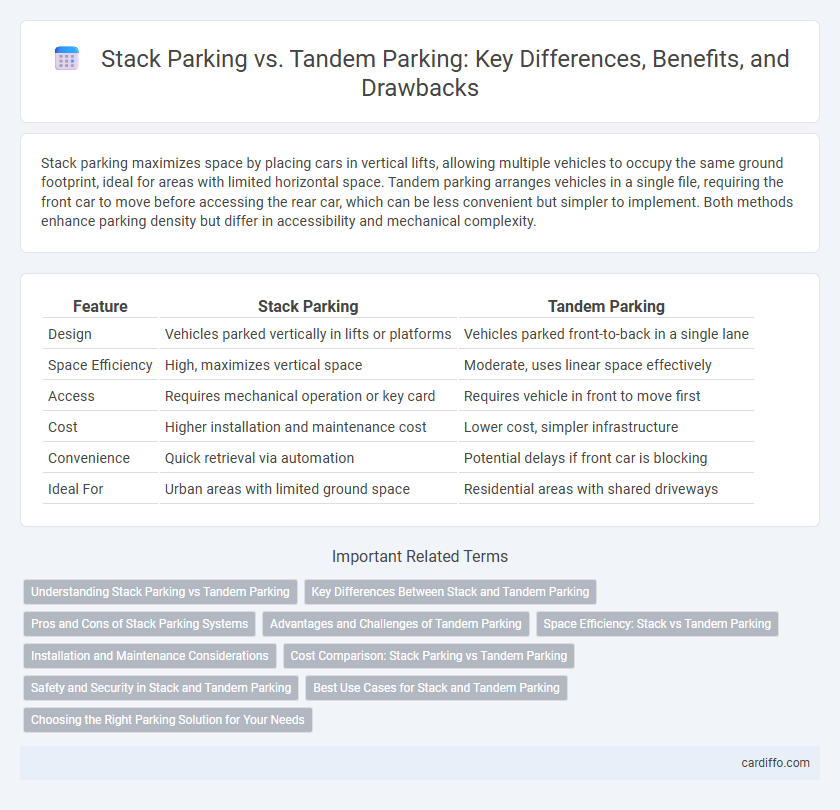Stack parking maximizes space by placing cars in vertical lifts, allowing multiple vehicles to occupy the same ground footprint, ideal for areas with limited horizontal space. Tandem parking arranges vehicles in a single file, requiring the front car to move before accessing the rear car, which can be less convenient but simpler to implement. Both methods enhance parking density but differ in accessibility and mechanical complexity.
Table of Comparison
| Feature | Stack Parking | Tandem Parking |
|---|---|---|
| Design | Vehicles parked vertically in lifts or platforms | Vehicles parked front-to-back in a single lane |
| Space Efficiency | High, maximizes vertical space | Moderate, uses linear space effectively |
| Access | Requires mechanical operation or key card | Requires vehicle in front to move first |
| Cost | Higher installation and maintenance cost | Lower cost, simpler infrastructure |
| Convenience | Quick retrieval via automation | Potential delays if front car is blocking |
| Ideal For | Urban areas with limited ground space | Residential areas with shared driveways |
Understanding Stack Parking vs Tandem Parking
Stack parking involves vertically aligning vehicles using mechanical lifts or platforms, maximizing space efficiency in limited areas. Tandem parking positions cars front-to-back in a single lane, requiring sequential movement to access the inner vehicle. Understanding these differences helps optimize parking layouts based on available space and user convenience.
Key Differences Between Stack and Tandem Parking
Stack parking utilizes mechanical lifts to park vehicles vertically in a single space, significantly increasing capacity without expanding the footprint, while tandem parking arranges two cars nose-to-tail in a single elongated space. Stack parking requires machinery and power, making it suitable for urban areas with space constraints, whereas tandem parking depends on vehicle movement coordination, often making the rear car inaccessible without moving the front car. Stack parking offers automation and space efficiency advantages, whereas tandem parking is simpler but requires more user cooperation and can cause delays.
Pros and Cons of Stack Parking Systems
Stack parking systems maximize space efficiency by allowing vehicles to be parked vertically, effectively doubling capacity in limited areas without expanding the footprint. These systems reduce land use costs and can be automated to improve convenience, though they require higher initial investment and can cause accessibility delays when retrieving cars stacked behind others. Maintenance needs and mechanical reliability impact user satisfaction, making stack parking ideal for locations prioritizing space optimization over immediate vehicle access.
Advantages and Challenges of Tandem Parking
Tandem parking maximizes space efficiency by allowing two vehicles to park in a single elongated spot, ideal for narrow lots or urban areas with limited space. It offers cost savings on land use and can increase overall parking capacity without expanding the lot footprint. Challenges include restricted vehicle access, as the front car must be moved to retrieve the rear one, which can cause inconvenience and require coordination among users.
Space Efficiency: Stack vs Tandem Parking
Stack parking maximizes space efficiency by allowing multiple vehicles to be parked vertically in the same footprint, ideal for high-density urban environments. Tandem parking arranges vehicles in a single file, which can limit accessibility but requires less complex mechanical systems. The vertical configuration of stack parking significantly increases vehicle capacity per square meter compared to the linear layout of tandem parking.
Installation and Maintenance Considerations
Stack parking systems require complex installation involving mechanical lifts and secure anchoring, which demands professional expertise and higher initial costs. Tandem parking is simpler to install, often needing only painted lines or minimal hardware, resulting in lower setup expenses and faster deployment. Maintenance for stack systems involves regular mechanical inspections and potential repairs, whereas tandem parking maintenance is limited to routine surface upkeep and occasional space re-marking.
Cost Comparison: Stack Parking vs Tandem Parking
Stack parking systems reduce space requirements by allowing vehicles to be parked vertically, often resulting in lower land costs compared to tandem parking, which arranges vehicles in a single line and may require more horizontal space. Installation and maintenance expenses for stack parking are typically higher due to mechanical lifts and complex infrastructure, whereas tandem parking has minimal setup costs, relying mainly on striping and driveway dimensions. Overall, stack parking offers cost efficiency in high-density areas where land prices are premium, while tandem parking remains a budget-friendly option for properties with ample horizontal space.
Safety and Security in Stack and Tandem Parking
Stack parking systems enhance safety by minimizing vehicle movement and reducing the risk of accidents through automated platforms. Tandem parking relies on driver coordination, which may increase the potential for fender benders and blocked vehicles during access or exit. Security is improved in stack parking with controlled access and surveillance integration, while tandem parking often lacks these features, making it more vulnerable to unauthorized entry.
Best Use Cases for Stack and Tandem Parking
Stack parking optimizes space in urban environments by allowing multiple cars to be parked vertically, making it ideal for locations with limited horizontal space such as multi-story residential buildings or commercial garages. Tandem parking suits narrow lots and private driveways where vehicles can be parked in a line, facilitating easy access for homeowners or small businesses with sequential vehicle use. Both methods enhance parking efficiency, with stack parking maximizing vertical capacity and tandem parking improving linear space utilization.
Choosing the Right Parking Solution for Your Needs
Stack parking maximizes space by allowing vehicles to be parked in vertical lifts, ideal for locations with limited ground area but requiring frequent access to each car. Tandem parking places cars in a single-file line, suitable for residential or small commercial properties where vehicles are used sequentially and not simultaneously. Selecting between stack and tandem parking depends on vehicle usage patterns, available space, and ease of access preferences, ensuring optimal convenience and efficiency.
Stack parking vs Tandem parking Infographic

 cardiffo.com
cardiffo.com